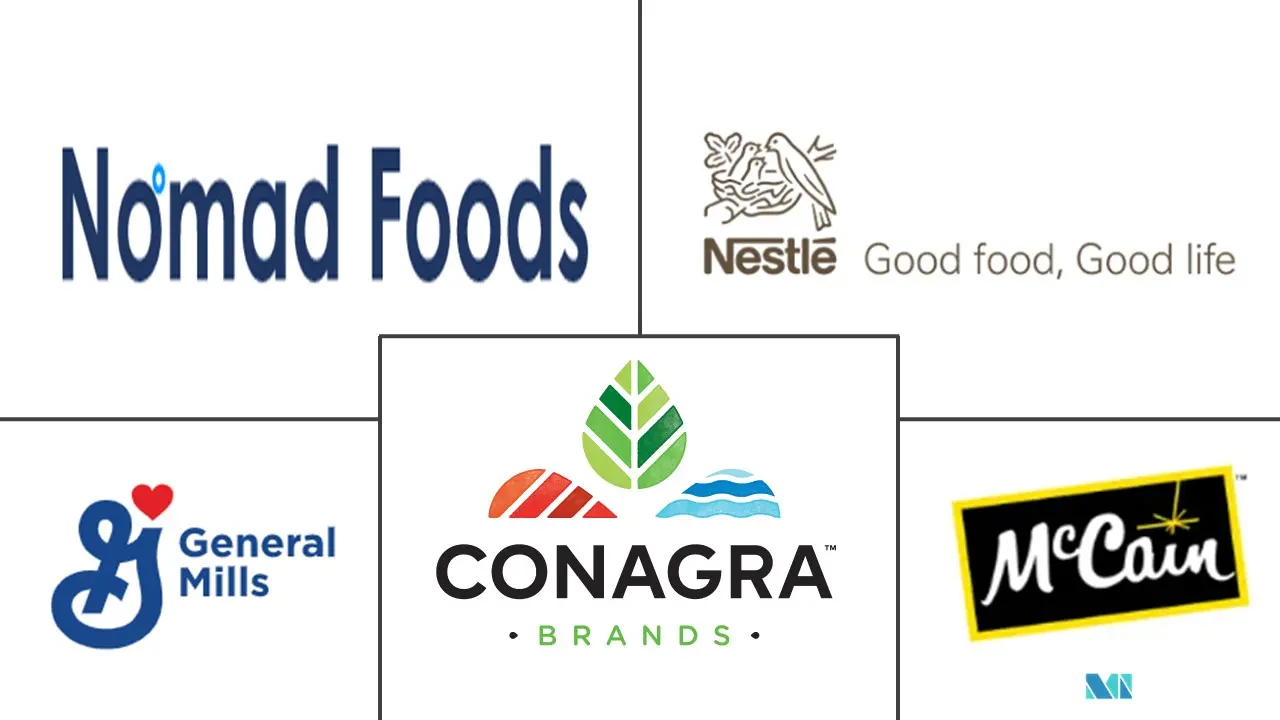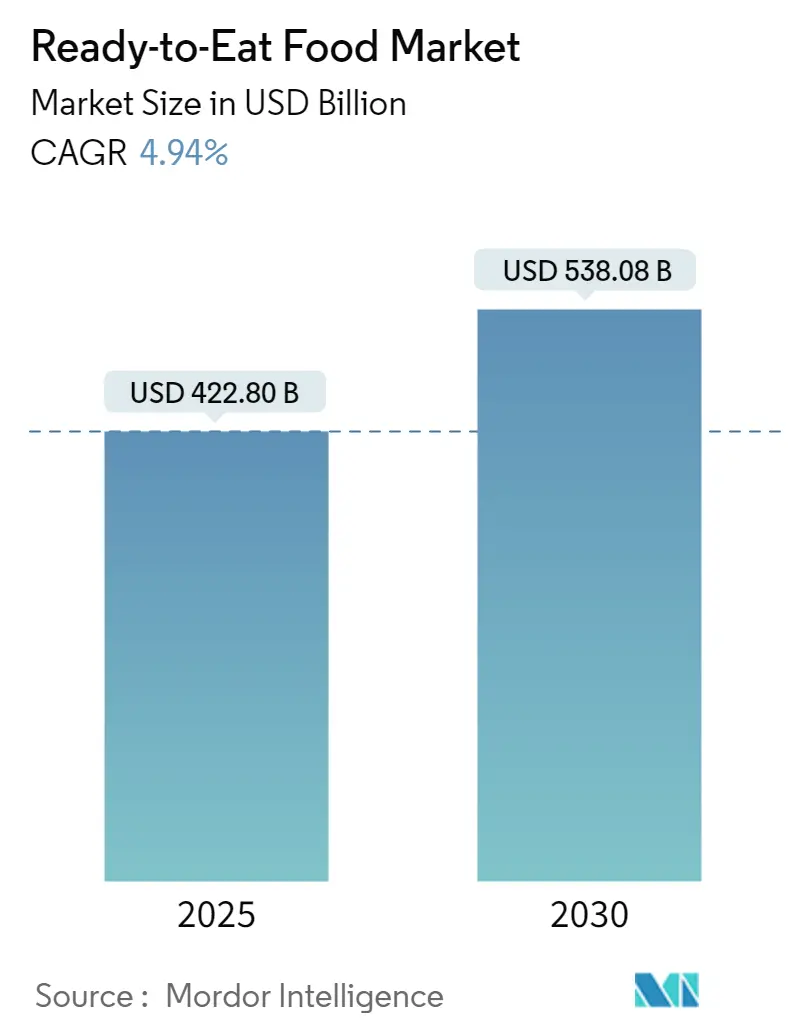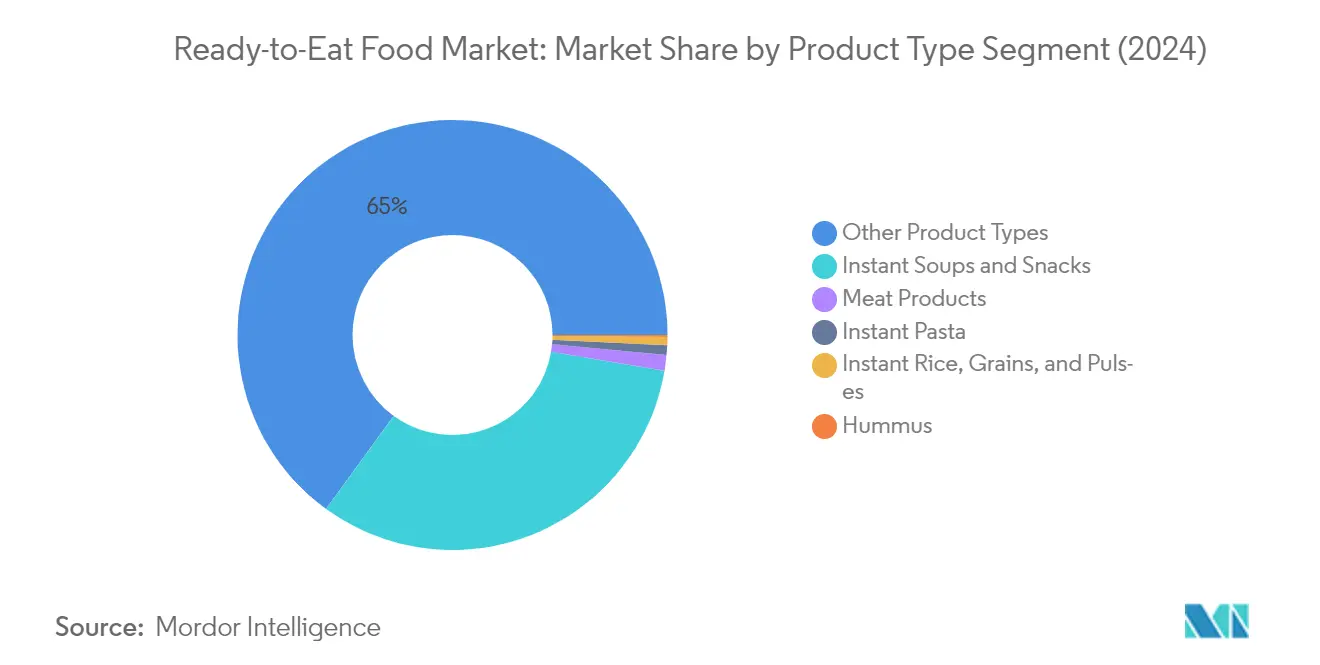Ready to Eat Food Market Analysis
The Ready-to-Eat Food Market size is estimated at USD 422.80 billion in 2025, and is expected to reach USD 538.08 billion by 2030, at a CAGR of 4.94% during the forecast period (2025-2030).
The ready-to-eat food industry is experiencing significant transformation driven by evolving consumer preferences and lifestyle changes. Modern consumers are increasingly seeking convenient meal solutions that align with their fast-paced lifestyles while maintaining nutritional value. The retail landscape has adapted to this shift, with major retailers expanding their ready-to-eat food market offerings. For instance, Walmart Inc., one of the largest retail chains, generates approximately 22% of its food market sales through dedicated shelf space and strategic positioning, highlighting the growing importance of this category in mainstream retail.
Product innovation and diversification have become crucial strategies in the ready-to-eat food market, with manufacturers focusing on ethnic and international cuisine varieties. Companies are expanding their product portfolios to include diverse cultural offerings, from Asian to Mediterranean cuisines, catering to consumers' growing interest in global flavors. This trend is particularly evident in developed markets, where the U.S. exports of consumer-ready foods to countries like Italy reached USD 443.7 million in 2020, demonstrating the strong international trade dynamics in this food industry market size.
The industry is witnessing a significant shift toward healthier and more sustainable options, with manufacturers reformulating products to meet changing consumer preferences. Companies are incorporating whole grains, reducing sodium content, and eliminating artificial ingredients while maintaining convenience and taste. The rice segment exemplifies this trend, with global consumption reaching 504.3 million metric tons in the 2020/2021 crop year, as consumers seek nutritious, easy-to-prepare meal options.
Packaging innovation and sustainability have emerged as key focus areas for industry players, with companies investing in eco-friendly packaging solutions and portion-controlled formats. Manufacturers are adopting recyclable materials and sustainable packaging technologies to reduce environmental impact while maintaining product freshness and convenience. For example, major companies like Nissin Food Products have introduced biomass-based packaging materials, achieving a biomass level of 81% in their products, demonstrating the industry's commitment to environmental sustainability while meeting consumer demands for convenient meal solutions.
Ready to Eat Food Market Trends
Surge in Demand for Convenient and Healthy Instant Food
The increasing demand for ready-to-eat food products is primarily driven by evolving social and economic patterns, coupled with changing consumer lifestyles and meal preferences. According to consumer research in the United States, approximately 76% of consumers choose ready-to-eat meals primarily for convenience and quick preparation, while 46% select these products based on taste and flavor preferences. This trend is particularly prominent among working professionals, university students, and urban households who seek nutritious yet easily preparable meal options. The integration of healthier ingredients and improved nutritional profiles in ready-to-eat foods has further accelerated market growth, as consumers increasingly prioritize wellness while maintaining convenience.
The on-the-go food concept has gained significant traction, particularly due to its association with easy consumption and handling characteristics. Major ready-to-eat food manufacturers are responding to this trend by introducing innovative product lines that combine convenience with nutritional value. For instance, Riviana Foods Inc. has expanded its portfolio to include several "better for you" products, including Ready to Serve Brown Rice & Quinoa, Ready to Serve White & Red Quinoa, a line of Ready to Serve Organics, and Minute Instant Multi-Grain Medley. These products cater to the growing consumer segment that seeks quick meal solutions without compromising on nutritional benefits. The trend toward smaller, more frequent meals throughout the day has also contributed to increased consumption of ready-to-eat food products, as consumers look for portable, portion-controlled options that align with their busy schedules.
Increasing Affinity Towards Ready-to-Eat Ethnic Cuisine
The growing multicultural population and increasing exposure to global cuisines have significantly influenced consumer preferences for ethnic ready-to-eat foods. Immigration patterns show substantial growth in Asian populations across Western countries, with Eastern Asia, South Central Asia, and South Eastern Asia each contributing over 4.2 million immigrants to the United States alone. This demographic shift has created a robust market for authentic ethnic cuisines, with retail data indicating that 50% of U.S. consumers purchase Italian ethnic food, followed by 44% purchasing Mexican food products. The expansion of ethnic food choices has moved beyond traditional offerings, with Japanese, Korean, Thai, and Vietnamese cuisines gaining popularity among 30% of consumers.
The trend towards ethnic ready-to-eat meals has prompted major food manufacturers to diversify their product portfolios with authentic international offerings. Companies are increasingly focusing on fusion cuisines and innovative product developments to cater to evolving consumer preferences. For example, Nestle SA's Indian arm launched ready-to-eat flattened rice (poha) and upma to capitalize on the growing demand for authentic Indian convenience foods. The younger consumer demographic, influenced by digital media and global food trends, continues to drive the demand for diverse ethnic ready-to-eat food options. This has led to the emergence of fusion products that combine traditional ethnic flavors with modern convenience, creating new market opportunities for manufacturers and retailers alike.
Segment Analysis: By Product Type
Instant Soups and Snacks Segment in Ready-to-Eat Food Market
The Instant Soups and Snacks segment has established itself as the dominant force in the ready-to-eat food market, commanding approximately 32% market share in 2024. This substantial market position is driven by the increasing consumer preference for convenient and quick meal solutions, particularly among working professionals and students. The segment's success is further bolstered by continuous product innovations focusing on healthier ingredients, diverse flavor profiles, and improved nutritional content. Ready-to-eat food manufacturers are actively expanding their product portfolios to include organic, low-sodium, and preservative-free options to cater to health-conscious consumers. The segment's growth is also supported by the rising trend of snackification and the increasing demand for portable, portion-controlled meal options that can be consumed on-the-go.
Meat Products Segment in Ready-to-Eat Food Market
The Meat Products segment is emerging as the fastest-growing category in the ready-to-eat food industry, projected to expand at approximately 8% CAGR during 2024-2029. This remarkable growth is primarily attributed to the increasing consumer demand for protein-rich convenience foods and the rising popularity of meat-based snacks. Manufacturers are focusing on innovative processing technologies and packaging solutions to extend shelf life while maintaining product quality. The segment is witnessing significant developments in premium and gourmet ready-to-eat food products, with companies introducing artisanal flavors and clean-label options. Additionally, the growing trend of high-protein diets and the rising popularity of meat-based snacking options among fitness enthusiasts are further propelling the segment's growth.
Remaining Segments in Ready-to-Eat Food Market
The other segments in the ready-to-eat food market, including Instant Rice, Grains, and Pulses, Instant Pasta, and Hummus, each play unique roles in meeting diverse consumer preferences. The Instant Rice, Grains, and Pulses segment is gaining traction due to the increasing demand for plant-based protein options and convenient meal solutions. The Instant Pasta segment continues to evolve with innovative flavors and healthier formulations, while the Hummus segment is expanding its presence through various flavor innovations and positioning as a healthy snacking option. These segments are collectively contributing to the market's diversification by offering varied options for different dietary preferences and consumption occasions.
Segment Analysis: By Packaging Type and Storage Type
Non-Microwaveable Segment in Ready-to-Eat Food Market
The non-microwaveable segment continues to dominate the global ready-to-eat food market, holding approximately 70% market share in 2024. This significant market position is attributed to the growing consumer preference for traditional heating methods and the perception that conventional oven or stovetop heating provides better taste and texture compared to microwave cooking. Many consumers believe that conventional heating methods better preserve food quality and provide more even heating distribution. The segment's dominance is further strengthened by the extensive range of products available in non-microwaveable packaging formats, including retort pouches, aluminum containers, and oven-safe trays, which cater to diverse consumer preferences and cooking habits across different regions.
Microwaveable Segment in Ready-to-Eat Food Market
The microwaveable segment is experiencing rapid growth in the ready-to-eat food market, projected to grow at approximately 8% during 2024-2029. This accelerated growth is driven by increasing urbanization, busier lifestyles, and the growing demand for convenient meal solutions. Manufacturers are investing heavily in innovative microwave-safe packaging technologies that enhance food quality and ensure even heating. The segment is witnessing significant technological advancements in packaging materials that maintain food texture and nutritional value while providing quick preparation options. The rising number of working professionals and single-person households, particularly in urban areas, is further fueling the demand for microwaveable ready meals.
Storage Types in Ready-to-Eat Food Market
The storage type segmentation in the ready-to-eat food market comprises room temperature storage and cold storage options. Room temperature storage continues to be the preferred choice for manufacturers and retailers due to lower operational costs and easier distribution logistics. These products typically have longer shelf life through advanced preservation techniques and packaging innovations. Cold storage products, while requiring more sophisticated supply chain management, are gaining popularity due to their perception of freshness and minimal preservation requirements. The choice of storage type significantly impacts product positioning, distribution strategies, and ultimately, market penetration across different regions and retail formats.
Segment Analysis: By Distribution Channel
Hypermarkets/Supermarkets Segment in Ready-to-Eat Food Market
Hypermarkets/supermarkets continue to maintain their dominance in the ready-to-eat food market, commanding approximately 48% of the total market share in 2024. These retail formats have established themselves as the preferred destination for ready meals purchases due to their extensive product selection, considerable shelf space, and frequent price promotions. The proximity factor of these channels, especially in large and developed cities worldwide, provides them with a significant advantage in influencing consumer purchasing decisions. Shopping at hypermarkets/supermarkets is perceived as particularly beneficial due to heavy discounts, product bundling opportunities, and attractive promotional schemes available for bulk purchases. These channels remain the primary choice for ready-to-eat food manufacturers to launch new products and increase their market presence, primarily due to the high customer footfall compared to other distribution channels.
Online Retailers Segment in Ready-to-Eat Food Market
The online retail segment is experiencing remarkable growth in the ready-to-eat food market, projected to expand at approximately 9% during 2024-2029. This substantial growth is driven by the increasing consumer preference for convenient and hassle-free shopping experiences. The segment's expansion is further supported by the extensive partnerships formed between online retailers and globally reputed players, along with dynamic collaborations with emerging domestic brands. These partnerships often include express delivery services, such as delivery of products within 2 hours from order placement, which significantly enhances consumer appeal. Major brands are actively developing their online presence through dedicated websites and partnerships with e-commerce platforms to provide greater convenience to customers. The wide variety of ready-to-eat food products available on online platforms, coupled with competitive pricing and doorstep delivery, continues to influence consumer purchasing decisions positively.
Remaining Segments in Ready-to-Eat Food Distribution Channels
The convenience stores segment maintains its significant position in the market by offering quick and easy access to ready-to-eat food products, particularly benefiting from impulse purchases and last-minute shopping needs. Food specialty stores have carved out their niche by focusing on premium and specialized ready-to-eat food products, often catering to health-conscious consumers and those seeking specific dietary requirements. These stores typically offer high-quality, artisanal, and unique ready-to-eat food options that may not be readily available in other retail formats. Traditional retail outlets and other distribution channels continue to serve specific market segments, particularly in regions where modern retail infrastructure is still developing, ensuring widespread availability of ready-to-eat food products across different consumer segments and geographical locations.
Ready-to-Eat Food Market Geography Segment Analysis
Ready-to-Eat Food Market in North America
North America represents one of the most mature markets for ready-to-eat foods, driven by busy lifestyles, increasing urbanization, and growing demand for convenient meal solutions. The region benefits from well-established retail infrastructure, a strong presence of major ready-to-eat food companies, and high consumer awareness about ready-to-eat products. The United States dominates the regional market, followed by Mexico and Canada, with consumers increasingly seeking healthier and premium ready-to-eat options. The market is characterized by continuous product innovations, expanding distribution networks, and a growing emphasis on organic and natural ingredients.
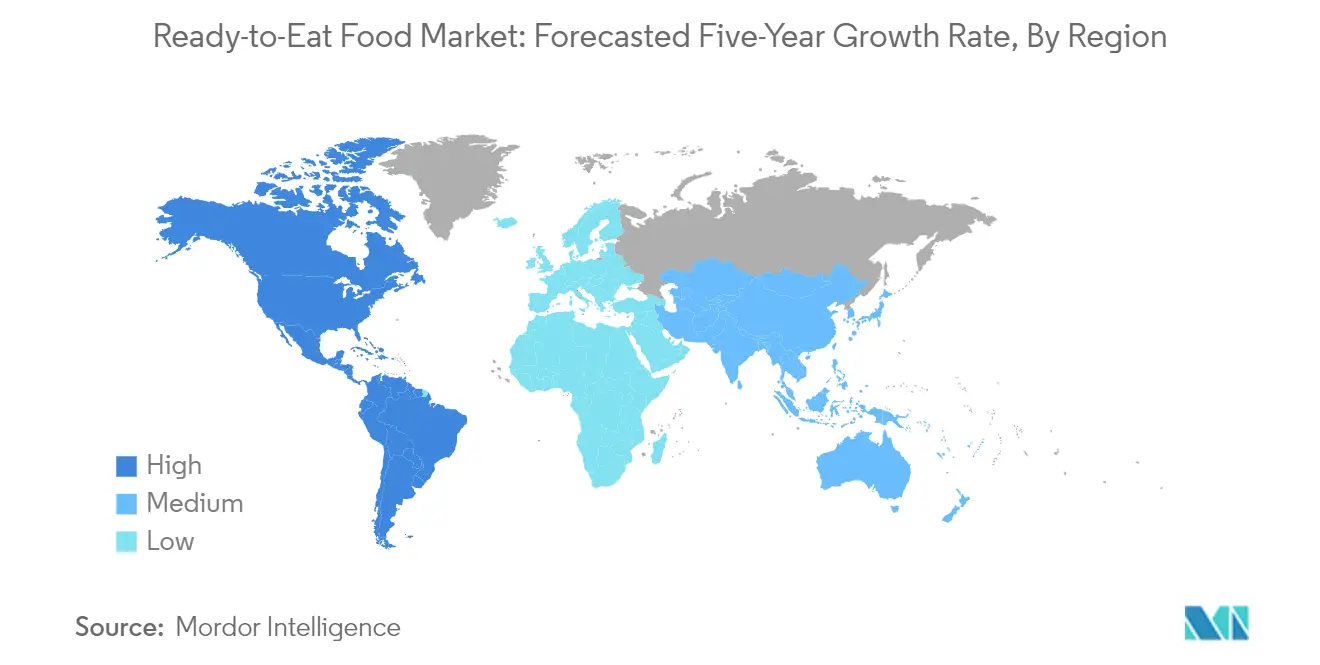
Ready-to-Eat Food Market in United States
The United States leads the North American ready-to-eat food market, leveraging its robust retail infrastructure and diverse consumer base. The market benefits from high disposable incomes, busy urban lifestyles, and a strong presence of major food manufacturers. American consumers are increasingly seeking healthier ready-to-eat options, driving manufacturers to focus on clean label products and natural ingredients. The country holds approximately 48% share of the global ready-to-eat food market in 2024, highlighting its dominant position. The market is characterized by strong distribution networks, innovative product launches, and a growing emphasis on sustainable packaging solutions.
Ready-to-Eat Food Market in Mexico
Mexico emerges as the fastest-growing market in North America, driven by rapid urbanization, changing consumer lifestyles, and increasing adoption of convenience foods. The country's ready-to-eat food market is expected to grow at approximately 7% CAGR during 2024-2029. This growth is supported by expanding retail infrastructure, rising disposable incomes, and a growing working population. Mexican consumers are increasingly embracing ready-to-eat products that offer both convenience and authentic local flavors. The market is witnessing significant investments in distribution networks and cold chain infrastructure to support the growing demand for ready-to-eat products.
Ready-to-Eat Food Market in Europe
Europe represents a sophisticated market for ready-to-eat foods, characterized by high consumer awareness, stringent quality standards, and innovative product offerings. The region benefits from advanced food processing technologies, well-established retail networks, and a growing demand for premium and organic ready-to-eat options. Countries like France, Germany, and the United Kingdom lead the market, while emerging economies in Eastern Europe present growth opportunities. The market is driven by busy urban lifestyles, increasing single-person households, and a growing preference for convenient meal solutions.
Ready-to-Eat Food Market in France
France maintains its position as the largest ready-to-eat food market in Europe, driven by sophisticated consumer preferences and a strong food culture. The country holds approximately 12% share of the European ready-to-eat food market in 2024. French consumers increasingly seek premium ready-to-eat options that combine convenience with high-quality ingredients and authentic flavors. The market benefits from strong retail infrastructure, innovative product development, and a growing demand for organic and natural ready-to-eat options. The country's food industry continues to invest in new product development and sustainable packaging solutions.
Ready-to-Eat Food Market in Spain
Spain emerges as the fastest-growing ready-to-eat food market in Europe, with an expected growth rate of approximately 5% during 2024-2029. The market benefits from changing consumer lifestyles, increasing urbanization, and a growing acceptance of convenience foods. Spanish consumers show an increasing preference for ready-to-eat products that offer authentic local flavors and high nutritional value. The market witnesses continuous product innovations, expanding distribution networks, and a growing focus on sustainable packaging solutions. The country's food industry actively invests in new product development and marketing strategies to capture growing consumer interest.
Ready-to-Eat Food Market in Asia-Pacific
The Asia-Pacific region represents a dynamic market for ready-to-eat foods, driven by rapid urbanization, changing consumer lifestyles, and increasing disposable incomes. The region witnesses strong growth in demand for convenient meal solutions, particularly in major economies like China, Japan, and South Korea. The market is characterized by diverse consumer preferences, expanding retail infrastructure, and a growing adoption of Western food habits. Regional manufacturers focus on product innovations that cater to local tastes while maintaining convenience and quality.
Ready-to-Eat Food Market in China
China dominates the Asia-Pacific ready-to-eat food market, supported by its large population base, rapid urbanization, and increasing disposable incomes. The country's market benefits from expanding retail infrastructure, a growing working population, and changing consumer lifestyles. Chinese consumers increasingly seek convenient meal solutions that offer both traditional and international flavors. The market witnesses significant investments in product development, distribution networks, and marketing strategies to capture growing consumer interest.
Ready-to-Eat Food Market in China - Growth Analysis
China also emerges as the fastest-growing market in the Asia-Pacific region, driven by rapid urbanization, an expanding middle class, and an increasing adoption of convenience foods. The market witnesses strong growth in demand across various product categories, particularly in urban areas. Chinese consumers show an increasing preference for premium ready-to-eat options that offer quality and convenience. The market benefits from continuous product innovations, expanding distribution networks, and a growing focus on food safety and quality standards.
Ready-to-Eat Food Market in South America
South America presents a growing market for ready-to-eat foods, with Brazil emerging as the largest market and Argentina showing the fastest growth in the region. The market benefits from increasing urbanization, a growing working population, and changing consumer lifestyles. Regional consumers show an increasing preference for convenient meal solutions that offer local flavors and good nutritional value. The market witnesses continuous product innovations, expanding retail infrastructure, and growing investments in distribution networks. Major food manufacturers actively expand their presence in the region through product launches and marketing initiatives.
Ready-to-Eat Food Market in Middle East & Africa
The Middle East & Africa region represents an emerging market for ready-to-eat foods, with Saudi Arabia leading in market size and South Africa showing the fastest growth. The market benefits from rapid urbanization, increasing disposable incomes, and a growing adoption of convenience foods. Regional consumers increasingly seek ready-to-eat products that align with local tastes and dietary preferences. The market witnesses growing investments in retail infrastructure, cold chain logistics, and product innovations. International food manufacturers actively expand their presence in the region through strategic partnerships and product launches.
Ready to Eat Food Industry Overview
Top Companies in Ready-to-Eat Food Market
The ready-to-eat food companies market features prominent players like Nestlé SA, General Mills, Conagra Brands, Mars Inc., and Kraft Heinz Company leading the industry through continuous innovation and strategic initiatives. These prepared food companies are heavily investing in research and development to launch new products catering to evolving consumer preferences, particularly focusing on healthier options, plant-based alternatives, and ethnic flavors. Operational agility has become paramount as manufacturers expand their production capabilities while optimizing supply chains to ensure efficient distribution. Strategic partnerships with technology companies and e-commerce platforms have enhanced digital presence and direct-to-consumer capabilities. Geographic expansion through both organic growth and acquisitions remains a key strategy, with companies particularly targeting emerging markets while strengthening their presence in established regions.
Consolidated Market with Strong Global Players
The ready-to-eat food market exhibits a highly consolidated structure dominated by multinational conglomerates with diverse product portfolios and extensive distribution networks. These large players leverage their established brand equity, manufacturing capabilities, and financial resources to maintain market leadership while continuously expanding through strategic acquisitions of regional players and innovative startups. The market also features specialized regional players who maintain strong positions in specific geographic markets or product categories through their deep understanding of local tastes and preferences.
Merger and acquisition activity remains robust as larger companies seek to acquire innovative brands, expand geographic presence, and gain access to new distribution channels. Companies are particularly interested in acquiring businesses with strong positions in emerging categories like plant-based foods, organic products, and ethnic cuisines. The industry has witnessed significant consolidation as major players seek to achieve economies of scale, enhance operational efficiency, and strengthen their competitive position through vertical integration and expansion of product portfolios.
Innovation and Adaptability Drive Market Success
Success in the ready-to-eat food market increasingly depends on companies' ability to innovate across product development, packaging, and distribution channels while maintaining operational efficiency. Incumbent players must focus on continuous product innovation, sustainable packaging solutions, and digital transformation initiatives to maintain their market position. Building strong relationships with retailers, investing in direct-to-consumer channels, and developing omnichannel capabilities have become crucial for maintaining competitive advantage. Companies must also focus on sustainability initiatives and transparent supply chains to meet growing consumer demands for environmentally responsible products.
New entrants and challenger brands can gain market share by focusing on niche segments, innovative product formulations, and unique value propositions that address specific consumer needs or preferences. Success factors include developing strong brand identities, leveraging e-commerce platforms, and building efficient supply chain networks. The regulatory environment, particularly regarding food safety, labeling requirements, and environmental standards, continues to shape market dynamics and influence company strategies. Companies must also address the growing bargaining power of large retailers while managing the risk of private label competition and changing consumer preferences.
Ready to Eat Food Market Leaders
-
Nomad Foods Ltd.
-
Conagra Brands, Inc.
-
Nestlé S.A.
-
General Mills, Inc.
-
McCain Foods Limited
- *Disclaimer: Major Players sorted in no particular order
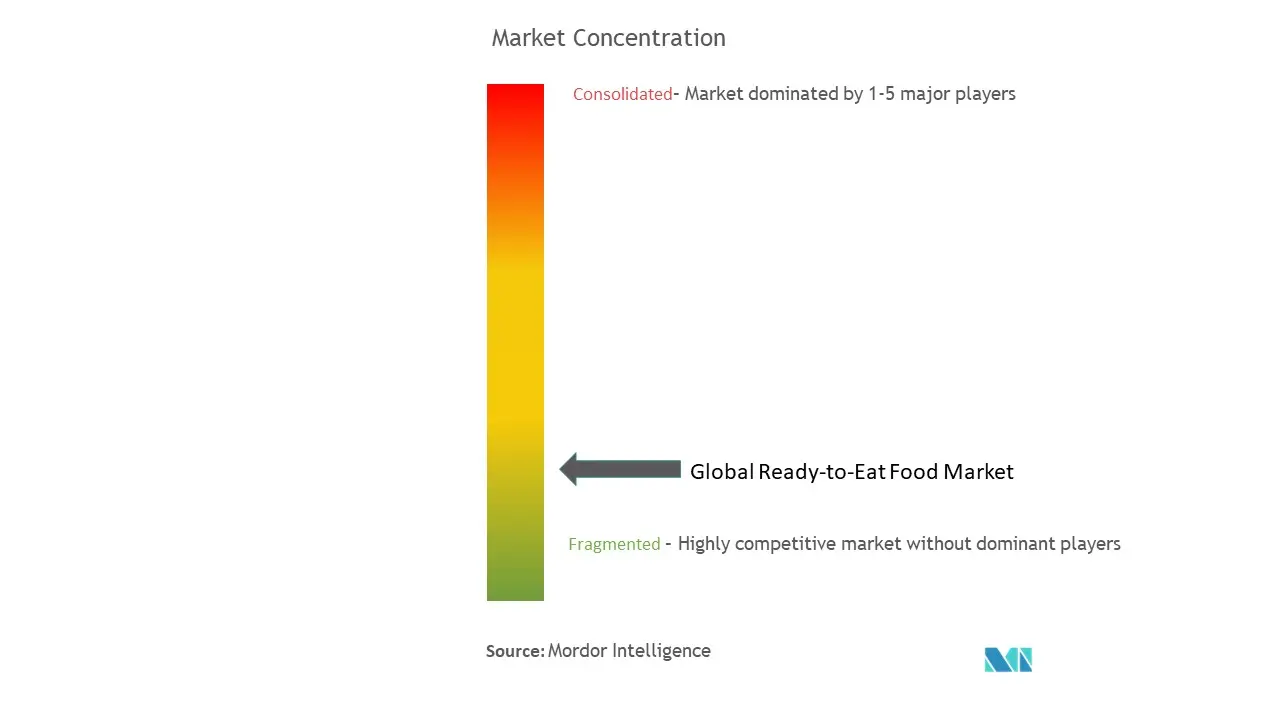
Ready to Eat Food Market News
- In September 2022, McCain Foods acquired Netherlands-based Scelta Products. This acquisition will strengthen the position of the company in prepared frozen appetizers and will add innovation and capacity to frozen appetizers.
- In August 2022, General Mills Inc. launched prepared meal kits under the brands of Betty Crocker, Old El Paso, Pillsbury, and Annie's Organic brands. It provides consumers with fully prepared, and ready-to-eat meal options for simple homemade dishes.
- In August 2021, the Nestlé-owned brand Freshly launched its first fully vegan meal line. Under its new purely plant menu, the chef-prepared meal delivery service will offer six options developed to showcase plant-based foods' nutritional benefits and delectable possibilities. The meals, which are ready to eat in approximately three minutes, are inspired by a variety of cuisines and include, Indian-Spiced Chickpea Curry Bowl with Basmati Rice, Lentils & Veggies; Farmstead Baked Pasta with Melty Cashew Cheeze & Seasonal Veggies (which features a coconut milk-based vegan cheese); Creamy Buffalo Cauli Mac & Cheeze with Garlic-Roasted Broccoli; and Moroccan Herb Falafel Bowl with Garlicky Hummus & Toasted Quinoa.
Ready to Eat Food Market Report - Table of Contents
1. INTRODUCTION
- 1.1 Study Assumptions and Market Definition
- 1.2 Scope of the Study
2. RESEARCH METHODOLOGY
3. EXECUTIVE SUMMARY
4. MARKET DYNAMICS
- 4.1 Market Drivers
- 4.2 Market Restraints
-
4.3 Porter's Five Forces Analysis
- 4.3.1 Threat of New Entrants
- 4.3.2 Bargaining Power of Buyers/Consumers
- 4.3.3 Bargaining Power of Suppliers
- 4.3.4 Threat of Substitute Products
- 4.3.5 Intensity of Competitive Rivalry
5. MARKET SEGMENTATION
-
5.1 Product Type
- 5.1.1 Instant Breakfast/Cereals
- 5.1.2 Instant Soups and Snacks
- 5.1.3 Ready Meals
- 5.1.4 Baked Goods
- 5.1.5 Meat Products
- 5.1.6 Other Product Types
-
5.2 Distribution Channel
- 5.2.1 Hypermarkets/Supermarkets
- 5.2.2 Convenience Stores
- 5.2.3 Online Retail Stores
- 5.2.4 Other Distribution Channels
-
5.3 Geography
- 5.3.1 North America
- 5.3.1.1 United States
- 5.3.1.2 Canada
- 5.3.1.3 Mexico
- 5.3.1.4 Rest of North America
- 5.3.2 Europe
- 5.3.2.1 Spain
- 5.3.2.2 United Kingdom
- 5.3.2.3 Germany
- 5.3.2.4 France
- 5.3.2.5 Italy
- 5.3.2.6 Russia
- 5.3.2.7 Rest of Europe
- 5.3.3 Asia-Pacific
- 5.3.3.1 China
- 5.3.3.2 Japan
- 5.3.3.3 India
- 5.3.3.4 Australia
- 5.3.3.5 Rest of Asia-Pacific
- 5.3.4 South America
- 5.3.4.1 Brazil
- 5.3.4.2 Argentina
- 5.3.4.3 Rest of South America
- 5.3.5 Middle-East and Africa
- 5.3.5.1 South Africa
- 5.3.5.2 Saudi Arabia
- 5.3.5.3 Rest of Middle-East and Africa
6. COMPETITIVE LANDSCAPE
- 6.1 Most Adopted Strategies
- 6.2 Market Share Analysis
-
6.3 Company Profiles
- 6.3.1 Nomad Foods Ltd
- 6.3.2 General Mills, Inc.
- 6.3.3 McCain Foods Limited
- 6.3.4 Nestlé S.A.
- 6.3.5 Premier Foods Group Limited
- 6.3.6 Conagra Brands, Inc.
- 6.3.7 Amy's Kitchen
- 6.3.8 Dr. August Oetker Nahrungsmittel KG
- 6.3.9 Campbell Soup Company
- 6.3.10 The Kraft Heinz Company
- *List Not Exhaustive
7. MARKET OPPORTUNITIES AND FUTURE TRENDS
Ready to Eat Food Industry Segmentation
Ready-to-eat foods are foods made for direct consumption and do not require much further processing. They are mostly consumed without prior preparation or cooking. The ready-to-eat food market is segmented by product type, distribution channel, and geography. Based on product type, the market is segmented into instant breakfast/cereals, instant soups and snacks, ready meals, baked goods, meat products, and other product types. Based on the distribution channel, the market is segmented into hypermarkets/supermarkets, convenience stores, online retail stores, and other distribution channels. Moreover, the study analyzes the ready-to-eat food market across geography, including North America, Europe, Asia-Pacific, South America, the Middle East, and Africa. For each segment, the market sizing and forecasts have been done on the basis of value (in USD million).
| Product Type | Instant Breakfast/Cereals | ||
| Instant Soups and Snacks | |||
| Ready Meals | |||
| Baked Goods | |||
| Meat Products | |||
| Other Product Types | |||
| Distribution Channel | Hypermarkets/Supermarkets | ||
| Convenience Stores | |||
| Online Retail Stores | |||
| Other Distribution Channels | |||
| Geography | North America | United States | |
| Canada | |||
| Mexico | |||
| Rest of North America | |||
| Europe | Spain | ||
| United Kingdom | |||
| Germany | |||
| France | |||
| Italy | |||
| Russia | |||
| Rest of Europe | |||
| Asia-Pacific | China | ||
| Japan | |||
| India | |||
| Australia | |||
| Rest of Asia-Pacific | |||
| South America | Brazil | ||
| Argentina | |||
| Rest of South America | |||
| Middle-East and Africa | South Africa | ||
| Saudi Arabia | |||
| Rest of Middle-East and Africa | |||
Ready to Eat Food Market Research FAQs
How big is the Ready-to-Eat Food Market?
The Ready-to-Eat Food Market size is expected to reach USD 422.80 billion in 2025 and grow at a CAGR of 4.94% to reach USD 538.08 billion by 2030.
What is the current Ready-to-Eat Food Market size?
In 2025, the Ready-to-Eat Food Market size is expected to reach USD 422.80 billion.
Who are the key players in Ready-to-Eat Food Market?
Nomad Foods Ltd., Conagra Brands, Inc., Nestlé S.A., General Mills, Inc. and McCain Foods Limited are the major companies operating in the Ready-to-Eat Food Market.
Which is the fastest growing region in Ready-to-Eat Food Market?
South America is estimated to grow at the highest CAGR over the forecast period (2025-2030).
Which region has the biggest share in Ready-to-Eat Food Market?
In 2025, the Asia-Pacific accounts for the largest market share in Ready-to-Eat Food Market.
What years does this Ready-to-Eat Food Market cover, and what was the market size in 2024?
In 2024, the Ready-to-Eat Food Market size was estimated at USD 401.91 billion. The report covers the Ready-to-Eat Food Market historical market size for years: 2019, 2020, 2021, 2022, 2023 and 2024. The report also forecasts the Ready-to-Eat Food Market size for years: 2025, 2026, 2027, 2028, 2029 and 2030.
Our Best Selling Reports
Ready-to-Eat Food Market Research
Mordor Intelligence provides a comprehensive analysis of the ready-to-eat food market, leveraging decades of expertise in food industry market research. Our detailed report examines food market segmentation, food sector analysis, and crucial food market data across global regions. We place special focus on emerging markets, such as the ready to eat food market in India. The analysis covers ready to eat food manufacturers, leading ready to eat food companies, and prominent ready to eat food brands. This provides detailed insights into food industry growth patterns and market dynamics.
Stakeholders benefit from our thorough examination of food market trends and food market insights. These are available in an easy-to-read report PDF format for immediate download. The report includes a comprehensive food market size analysis, ready to eat food production statistics, and a detailed evaluation of ready to eat food products. Our research supports strategic decision-making for ready meals companies and industry participants. It offers valuable insights into food market growth opportunities and emerging ready to eat industry segments. The report includes a detailed analysis of ready meals market size, food industry market size, and projected expansion in the ready to eat food business sector.

